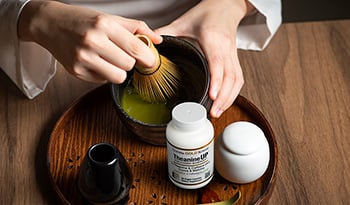L-茶氨酸,健康益处与认知功能
免责声明:本博客不提供诊断⋯

氨基酸L-茶氨酸(γ-N-乙基谷氨酰胺),天然存在于茶叶和食用褐绒盖牛肝菌(学名:Xerocomus badius)中。绿茶和红茶来自相同的植物。红茶是通过发酵制成的,而绿茶没有经过发酵。绿茶已经成为中药的主要支柱超过三千年,人们将其与其他草药一起作为药剂,也将其作为浓缩液单独使用,旨在增强耐力和集中注意力。L-茶氨酸的含量取决于茶树的生长地点、制作方法和收获时间。不同种类的茶如普洱茶比更为大众所熟知的山茶的L-茶氨酸的含量要高。也有合成形式的L-茶氨酸(Suntheanine™)。
L-茶氨酸在亚洲国家被广泛用于对抗各种医学和心理健康问题,并且在西方国家迅速普及。咖啡因是茶中的另一种主要成分,可能提高大脑中乙酰胆碱和多巴胺的水平,从而可能改善注意力、认知和情绪。就认知益处而言,咖啡因比L-茶氨酸的效果更快,因为它被更快地吸收,在30分钟后达到血浆峰值水平,与摄入L-茶氨酸50分钟后的血浆峰值水平相比。除了茶氨酸和咖啡因外,茶叶还含有其他成分,可能带来各种健康益处,包括氨基酸 谷氨酰胺、精氨酸、丝氨酸和丙氨酸和酚类化合物表没食子儿茶素、表儿茶素没食子酸酯、表儿茶素和表没食子儿茶素没食子酸酯(所谓的‘儿茶素‘)。抹茶是一种特殊的绿茶产品,与普通绿茶相比含有更高水平的有益植物化学物质。
动物和人类研究显示L-茶氨酸可能减少主观的压力反应、提高认知能力、优化睡眠,并可能对慢性疾病、心血管疾病、肥胖和普通伤风具有保护作用。包括L-茶氨酸、咖啡因和儿茶素在内的各种绿茶成分可能有助于预防代谢综合征和肥胖症。L-茶氨酸可能减少由活性氧类物质(即“自由基”)引起的氧化损伤,增加肝脏中的谷胱甘肽浓度,增强肝酶如超氧化物歧化酶清除血液中的毒素的能力。研究结果表明,L-茶氨酸可能具有延缓衰老的功效。来自绿茶的儿茶素可能具有有益的抗微生物和防病毒活性。在胃肠道中,绿茶已被证实可能激活细胞内的防氧化剂并阻抑前致癌物的形成。
L-茶氨酸和神经精神疾病
L-茶氨酸已被证实可能改善学习、记忆和认知功能,并增强精神任务中的选择性注意力。流行病学研究显示经常食用由山茶树叶制成的茶,可能与认知下降的发生率降低、情绪改善和应对压力的能力增强有关。L-茶氨酸可能是一种富有前景的精神分裂症增强疗法,可能对情绪障碍、注意力缺陷多动障碍(ADHD)以及恐慌症、强迫症(OCD)和双相情感障碍有益。
安慰剂对照研究已经研究了L-茶氨酸单独或与咖啡因结合使用对情绪和认知表现的影响,发现认知功能在综合疗法中可能有所增强,但对单独使用L-茶氨酸没有反应。两项关于茶成分对急性精神病在情绪和认知方面的影响的荟萃分析发现,L-茶氨酸可能改善了自我感觉的放松、减少了主观的紧张感,并且咖啡因可能改善了要求的认知任务的表现,并可能提高了警觉性和活力。
动物研究显示L-茶氨酸可能迅速穿过血脑屏障,提高大脑中血清素、γ-氨基丁酸和多巴胺的水平,与谷氨酸和NMDA受体结合,并可能增加脑源性神经营养因子(BDNF)的水平。长期服用L-茶氨酸(即超过3至4周)可能具有一般的神经保护作用,这可能是由海马体(在记忆巩固中发挥核心作用的大脑区域)中脑源性神经营养因子(BDNF)合成增加所引起的。所有这些影响都被认为可能缓解焦虑。
由于L-茶氨酸通常与咖啡因和茶中的其他生物活性成分一起摄入,大多数研究调查了L-茶氨酸和咖啡因对情绪和认知的综合影响。
L-茶氨酸,焦虑和压力
L-茶氨酸的抗焦虑效果是通过不同的机制介导的,包括提升α-脑波活动,增加γ-氨基丁酸的合成,以及它作为AMPA谷氨酸受体的弱拮抗剂的作用。L-茶氨酸的一般镇定益处反映在α频率范围(8至13Hz)内的脑电活动增加。通过脑电图(EEG)测量的脑电活动的变化是剂量依赖性的,并且类似于在冥想中观察到的有益的EEG变化,包括在枕骨和顶叶区域中增加的α波。在给予200毫克剂量的L-茶氨酸后,显示增加的α活性可能持续60分钟,并且这种效果在具有更高特质焦虑的个体中更显着。终末,研究发现,摄入高L-茶氨酸含量的绿茶可能缓解暴露于慢性应激的小鼠的肾上腺肥大。
根据特定种类的茶叶中的L-茶氨酸和咖啡因的相对含量及其制备方法,饮用绿茶以减轻压力或焦虑的个体可能会比刺激作用产生更大的镇定效果。在服用50至200毫克剂量的L-茶氨酸后30至40分钟内,通常可能会注意到一般的镇定作用,并且通常持续8至10小时。中度焦虑性神经症通常每天服用一次或两次,每次200毫克后产生效果。更严重的焦虑可能需要每天600毫克至800毫克的剂量,在一天中以100毫克至200毫克的间隔增量服用。与苯二氮卓类和其他医生开具的抗焦虑药剂不同,L-茶氨酸可能不会引起嗜睡、反应迟钝或注意力不集中,可能不存在产生耐受性或依赖性的风险。暂无L-茶氨酸和精神药剂或其他天然产物之间严重不良副作用或相互作用的相关报告。
关于状态焦虑的L-茶氨酸的研究结果可能有所差异。结果的差异可能与检查的不同患者群体有关,并且一些研究调查了咖啡因与L-茶氨酸的组合。安慰剂对照试验将L-茶氨酸200毫克/天与苯二氮卓类阿普唑仑进行比较,可能发现了一般抗焦虑作用的证据,但无法缓解实验诱导的状态焦虑。相比之下,另外两项研究报告指出,针对相同剂量L-茶氨酸的反应,主观压力测量值可能显着降低,例如心率和血压降低。在一项为期4周的安慰剂对照试验(N=30)中,与安慰剂组相比,没有精神疾病的成年人随机接受200毫克/天的L-茶氨酸的状态焦虑可能有所缓解并且睡眠改善可能明显更多。在一项小型安慰剂对照试验中,16名健康成年志愿者随机分为L-茶氨酸200毫克/天、阿普唑仑1毫克或安慰剂,同时在放松和实验诱导的急性焦虑情况下进行监测。L-茶氨酸在基线条件下可能具有一些放松作用,但在放松状态或实验诱导的焦虑状态期间,阿普唑仑和L-茶氨酸可能皆没有比安慰剂表现出更大的抗焦虑作用。
在一项为期10周的安慰剂对照研究中(N=46),DSM-5诊断为广泛性焦虑性神经症的成年人随机接受L-茶氨酸(450至900毫克/天)或安慰剂,同时继续他们目前的药剂疗法。辅助性L-茶氨酸组在降低焦虑或优化睡眠方面的表现可能并不优于安慰剂组。在一项小型安慰剂对照研究(N=34)中,18-40岁的健康成人被给予L-茶氨酸饮料或安慰剂,然后进行多任务认知应激源。服用饮料1小时后,与安慰剂组相比,L-茶氨酸组报告的应激反应可能显着地降低。另一项关于含有L-茶氨酸200毫克、磷脂酰丝氨酸1毫克、洋甘菊10毫克和甘油磷酸胆碱25毫克的营养饮料的研究发现,摄入后1小时主观应激反应可能显着地降低,摄入后3小时血清皮质醇水平可能显着地降低。
L-茶氨酸和其他精神疾病
一项安慰剂对照研究发现,每日两次服用L-茶氨酸100毫克可能显着地改善ADHD男孩的睡眠质量,意味着L-茶氨酸可能是ADHD的有效辅助疗法。L-茶氨酸不会引起嗜睡,但在睡前服用200毫克L-茶氨酸可能通过缓解焦虑来优化睡眠。
新兴研究结果支持L-茶氨酸可能对抑郁情绪和精神病的症状有益。在一项为期8周的开放性研究(N=20)中,被诊断患有重度抑郁症的成年人使用L-茶氨酸250毫克/天的疗法,报告情绪、焦虑和睡眠质量可能有所改善。
L-茶氨酸也可能对与精神病有关的焦虑产生有益的作用。一项为期8周的安慰剂对照试验的结果表明,增加精神分裂症和分裂情感障碍患者的L-茶氨酸剂量可能降低焦虑水平。在该群体中增加L-茶氨酸剂量的有益效果可能通过皮质醇和脑源性神经营养因子(BDNF)的增加来介导。含有神经甾体孕烯醇酮和氨基酸L-茶氨酸的组合疗法可能对精神病症状有益。为期8周的双盲安慰剂对照试验(N=40)中,在成人精神分裂症或分裂情感障碍对抗精神病药反应不佳时,随机分为孕烯醇酮(50毫克/天)加L-茶氨酸(400毫克/天)或安慰剂,同时继续服用抗精神病药剂。在研究结束时,与安慰剂组相比,使用孕烯醇酮加L-茶氨酸疗法的患者的精神病阴性症状可能明显减少,如迟钝情绪、快感缺乏和言语缺乏、焦虑显着减少,以及一般功能可能得到更多的改善。
L-茶氨酸脑血管疾病和中风
动物研究的结果显示,L-茶氨酸可能有助于预防脑血管疾病并减轻脑血管意外(即中风)的影响。短暂性脑缺血后L-茶氨酸的神经保护作用可能与其作为AMPA谷氨酸受体拮抗剂的作用有关。在经历实验诱导的重复发作的脑缺血之前使用L-茶氨酸(0.3至1毫克/千克)处理的大鼠可能表现出空间记忆障碍的显著减少和神经细胞衰亡的显著减少。
参考:
- Bond, A.; Lader, M. The use of analogue scales in rating subjective feelings.Br.J. Med.Psychol. 1974, 47, 211–218.
- Boros, K., N. Jedlinszki and D. Csupor, 2016. Theanine and caffeine content of infusions prepared from commercial tea samples.Theanine and caffeine content of infusions prepared from commercial tea samples.Pharmacog.Mag., 12:75-79.
- Camfield DA, Stough C, Farrimond J, Scholey AB. (2014) Acute effects of tea constituents L-theanine, caffeine, and epigallocatechin gallate on cognitive function and mood: a systematic review and meta-analysis.Nutr Rev.;72(8):507-22.
- Chu, D.C., 1997. Green Tea-Its Cultivation, Processing of the Leaves for Drinking Materials and Kinds of Green Tea.In:Chemistry and Applications of Green Tea, Yamamoto, T., J.R. Lekh, D.C. Chu and M. Kim (Eds.)., CRC Press, Boca Raton, pp:1-11.
- Culetu, A., B. Fernandez-Gomez, M. Ullate, M.D. del Castillo and W. Andlauer, 2016. Effect of theanine and polyphenols enriched fractions from decaffeinated tea dust on the formation of Maillard reaction products and sensory attributes of breads.Food Chem., 197:14-23.
- Dietz C, Dekker M. (2017) Effect of Green Tea Phytochemicals on Mood and Cognition.Curr Pharm Des. 2017;23(19):2876-2905.
- Egashira N, Ishigami N, Pu F, Mishima K, Iwasaki K, Orito K, Oishi R, Fujiwara M. (2008) Theanine prevents memory impairment induced by repeated cerebral ischemia in rats.Phytother Res. 2008 Jan;22(1):65-8.
- Einöther SJ, Giesbrecht T. (2013) Caffeine as an attention enhancer: reviewing existing assumptions.Psychopharmacology (Berl). 2013 Jan;225(2):251-74.
- Einother, S.J.; Martens, V.E. Acute effects of tea consumption on attention and mood.Am.J. Clin.Nutr. 2013, 98, 1700S–1708S.
- Gong, Y., Y. Luo, J.A. Huang, J. Zhang, Y. Peng, Z. Liu and Z. Baolu, (2012). Theanine improves stress resistance in Caenorhabditis elegans.J. Funct.Foods, 4:988-993.
- Haskell, C.F.; Dodd, F.L.; Wightman, E.L.; Kennedy, D.O. (2013) Behavioural effects of compounds co-consumed in dietary forms of caffeinated plants.Nutr.Res.Rev., 26, 49–70.
- Haskell, C.F.; Kennedy, D.O.; Milne, A.L.; Wesnes, K.A.; Scholey, A.B. (2008) The effects of L-theanine, caffeine and their combination on cognition and mood.Biol.Psychol. 2008, 77, 113–122.
- Heiss, M.L. and R.J. Heiss, 2008. The Story of Tea:A Cultural History and Drinking Guide.Ten Speed Press, Berkeley, CA/Toronto, Canada.
- Hidese S, Ota M, Wakabayashi C, Noda T, Ozawa H, Okubo T, Kunugi H. Effects of chronic l-theanine administration in patients with major depressive disorder: an open-label study.Acta Neuropsychiatr. 2017 Apr;29(2):72-79.
- Higashiyama A, Htay HH, Ozeki M, et al. (2011) Effects of l-theanine on attention and reaction time response.J Funct Foods.;3:171–178.
- Higashiyama, A., H.H. Htay, M. Ozeki, L.R. Juneja and M.P. Kapoor, 2011. Effects of L-theanine on attention and reaction time response.J. Funct.Foods, 3:171-178.
- Hintikka J, Tolmunen T, Honkalampi K, et al. (2005) Daily tea drinking is associated with a low level of depressive symptoms in the Finnish general population.Eur J Epidemiol.;20:359–363.
- Hiroshi Kunugi, Shinsuke Hidese, Shintaro Ogawa, Miho Ota, Zenta Yasukawa, and Makoto Ozeki (2019) Effects of Chronic L-theanine on Stress-related Symptoms and Cognitive Function in a Non-clinical Population:A Randomized Controlled Trial (P06-106-19) Curr Dev Nutr. 13;3(Suppl 1). pii: nzz031.P06-106-19.
- Hozawa A, Kuriyama S, Nakaya N, et al. (2009) Green tea consumption is associated with lower psychological distress in a general population: the Ohsaki Cohort 2006 Study.Am J Clin Nutr. 2009; 90:1390–1396.
- Ikeda, I. (2008) Multifunctional effects of green tea catechins on prevention of the metabolic syndrome.Asia Pac J Clin Nutr. 2008;17 Suppl 1:273-4.
- Ito, K.; Nagato, Y.; Aoi, N.; Juneja, L.R.; Kim, M.; Yamamoto, H.; Sugimoto, S. (1998) Effects of L-theanine on the release of alpha-brain waves in human volunteers.Nippon N¯ogei Kagakukaishi, 72, 153–157.
- Jang, S.I., M.H. Jun, H.S. Lillehoj, R.A. Dalloul, I.K. Kong, S. Kim and W. Min, 2007. Anticoccidial effect of green tea-based diets against Eimeria maxima.Vet.Parasitol., 144:172-175.
- Juneja, L. R., Chu, D.-C., Okubo, T., et al. (1999).L-theanine, a unique amino acid of green tea, and its relaxation effect in humans.Trends in Food Science Technology, 10, 199–204.
- Kakuda, T. (2002) Neuroprotective effects of the green tea components theanine and catechins.Biol Pharm Bull. 2002 Dec;25(12):1513-8.
- Kakuda, T. (2011) Neuroprotective effects of theanine and its preventive effects on cognitive dysfunction.Pharmacol Res. 2011 Aug;64(2):162-8.
- Kakuda, T., Nozawa, A., Unno, T., et al. (2000).Inhibiting effects of theanine on caffeine stimulation evaluated by EEG in the rat.Bioscience Biotechnology Biochemistry, 64, 287–293.
- Kakuda, T.; Nozawa, A.; Sugimoto, A.; Niino, H. (2002) Inhibition by theanine of binding of [3H] AMPA, [3H] kainate, and [3H] MDL 105,519 to glutamate receptors.Biosci.Biotechnol.Biochem., 66, 2683–2686.
- Kardashev A, Ratner Y, Ritsner MS. (2018) Add-On Pregnenolone with L-Theanine to Antipsychotic Therapy Relieves Negative and Anxiety Symptoms of Schizophrenia:An 8-Week, Randomized, Double-Blind, Placebo-Controlled Trial.Clin Schizophr Relat Psychoses.;12(1):31-41.
- Kimura K, Ozeki M, Juneja LR, et al. (2007) L-Theanine reduces psychological and physiological stress responses.Biol Psychol.;74:39–45.
- Koo, M., Cho, C. (2004) Pharmacological effects of green tea on the gastrointestinal system.Eur J Pharmacol. 2004 Oct 1;500(1-3):177-85.
- Lardner, A., (2014) Neurobiological effects of the green tea constituent theanine and its potential role in the treatment of psychiatric and neurodegenerative disorders.Nutr Neurosci. 2014 Jul;17(4):145-55.
- Li, G., Y. Ye, J. Kang, X. Yao and Y. Zhang et al.,( 2012). L-Theanine prevents alcoholic liver injury through enhancing the antioxidant capability of hepatocytes.Food Chem.Toxicol., 50:363-372.
- Li, L., X.R. Wang, Y. Xiong, W.K. Ren and M. Huang et al., 2013. L-theanine:A promising substance in tumor research.J. Food Agric.Environ., 11:25-27.
- Lu K, Gray MA, Oliver C, Liley DT, Harrison BJ, Bartholomeusz CF, Phan KL, Nathan PJ. (2004) The acute effects of L-theanine in comparison with alprazolam on anticipatory anxiety in humans.Hum Psychopharmacol.;19(7):457-65.
- Lyon MR, Kapoor MP, Juneja LR. (2011) The effects of L-theanine (Suntheanine®) on objective sleep quality in boys with attention deficit hyperactivity disorder (ADHD): a randomized, double-blind, placebo-controlled clinical trial.Altern Med Rev. 2011 Dec;16(4):348-54.
- Mason, R. (2001). 200 mg of Zen:L-theanine boosts alpha waves, promotes alert relaxation.Alternative and Complementary Therapies, 7, 91–95.
- Miodownik C, Maayan R, Ratner Y, Lerner V, Pintov L, Mar M, Weizman A, Ritsner MS. (2011) Serum levels of brain-derived neurotrophic factor and cortisol to sulfate of dehydroepiandrosterone molar ratio associated with clinical response to L-theanine as augmentation of antipsychotic therapy in schizophrenia and schizoaffective disorder patients.Clin Neuropharmacol. 2011 Jul-Aug;34(4):155-60.
- Muhammad Saeed, Mohamed Ezzat Abd El-Hack, Mahmoud Alagawany, et al. (2017) Review Article Phytochemistry, Modes of Action and Beneficial Health Applications of Green Tea (Camellia sinensis) in Humans and Animals, International Journal of Pharmacology 13(7):698-708
- Nathan PJ, Lu K, Gray M, Oliver C. (2006) The neuropharmacology of L-theanine(N-ethyl-L-glutamine): a possible neuroprotective and cognitive enhancing agent.J Herb Pharmacother. 2006;6(2):21-30.
- Rao TP, Ozeki M, Juneja LR. (2015) In Search of a Safe Natural Sleep Aid.J Am Coll Nutr. 2015;34(5):436-47.
- Rogers PJ, Smith JE, Heatherley SV, et al. (2008) Time for tea: mood, blood pressure and cognitive performance effects of caffeine and theanine administered alone and together.Psychopharmacology (Berl).;195:569–577.
- Saito, K., M. Ikeda and H. Kametani, 2011. Theanine in the tea roots attenuates memory deficits in the aged rats.Free Radical Biol.Med., Vol. 51.
- Sarris J, Byrne GJ, Cribb L, Oliver G, Murphy J, Macdonald P, Nazareth S, Karamacoska D, Galea S, Short A, Ee C, Birling Y, Menon R, Ng CH. (2019) L-theanine in the adjunctive treatment of generalized anxiety disorder:A double-blind, randomised, placebo-controlled trial, J Psychiatr Res.;110:31-37.
- Shacham, S. (1983) A shortened version of the Profile of Mood States.J. Pers.Assess., 47, 305–306.
- Shen, H., X. Shen, R. Wang and M. Wu, 2011. Effects of theanine on cerebral ischemia-reperfusion injury in rats.J. Hygiene Res., 40:684-687.
- Song JM, Seong BL. (2007) Tea catechins as a potential alternative anti-infectious agent.Expert Rev Anti Infect Ther. 2007 Jun;5(3):497-506.
- Song, H.J., Y.D. Kim, M.J. Jeong, M.S. Ahn, S.W. Kim, J.R. Liu and M.S. Choi, 2015. Rapid selection of theanine-rich green tea (Camellia sinensis L.) trees and metabolites profiling by Fourier transform near-infrared (FT-IR) spectroscopy.Plant Biotechnol.Rep., 9:55-65.
- Tamano, H.; Fukura, K.; Suzuki, M.; Sakamoto, K.; Yokogoshi, H. (2014) Takeda, A. Advantageous effect of theanine intake on cognition.Nutr.Neurosci., 17, 279–283.
- Thangarajan, S., A. Deivasigamani, S.S. Natarajan, P. Krishnan and S.K. Mohanan, 2014. Neuroprotective activity of L-theanine on 3-nitropropionic acid-induced neurotoxicity in rat striatum.Int.J. Neurosci., 124:673-684.
- Türközü D, Şanlier N. (2017) L-theanine, unique amino acid of tea, and its metabolism, health effects, and safety.Crit Rev Food Sci Nutr. 24;57(8):1681-1687.
- Unno K, Hara A, Nakagawa A, Iguchi K, Ohshio M, Morita A, Nakamura Y. (2016) Anti-stress effects of drinking green tea with lowered caffeine and enriched theanine, epigallocatechin and arginine on psychosocial stress induced adrenal hypertrophy in mice.Phytomedicine. 2016 Nov 15;23(12):1365-1374.
- Van der Pijl PC, Chen L, Mulder TPJ. (2010) Human disposition of L-theanine in tea or aqueous solution.J Funct Foods.;2:239–244.
- Vuong, Q.V., M.C. Bowyer and P.D. Roach, 2011. L-Theanine:Properties, synthesis and isolation from tea.J. Sci.Food Agric., 91:1931-1939.
- Wakabayashi, C.; Numakawa, T.; Ninomiya, M.; Chiba, S.; Kunugi, H. (2012) Behavioral and molecular evidence for psychotropic effects in L-theanine.Psychopharmacology 2012, 219, 1099–1109.
- White DJ, de Klerk S, Woods W, Gondalia S, Noonan C, Scholey AB. (2016) Anti-Stress, Behavioural and Magnetoencephalography Effects of an L-Theanine-Based Nutrient Drink:A Randomised, Double-Blind, Placebo-Controlled, Crossover Trial.Nutrients. 2016 Jan 19;8(1). pii:E53.
- Zheng G, Sayama K, Okubo T, Juneja LR, Oguni I. (2004) Anti-obesity effects of three major components of green tea, catechins, caffeine and theanine, in mice.In Vivo.;18(1):55-62.

 作者 詹姆斯·莱克博士(Dr. James Lake),医级博士
作者 詹姆斯·莱克博士(Dr. James Lake),医级博士


